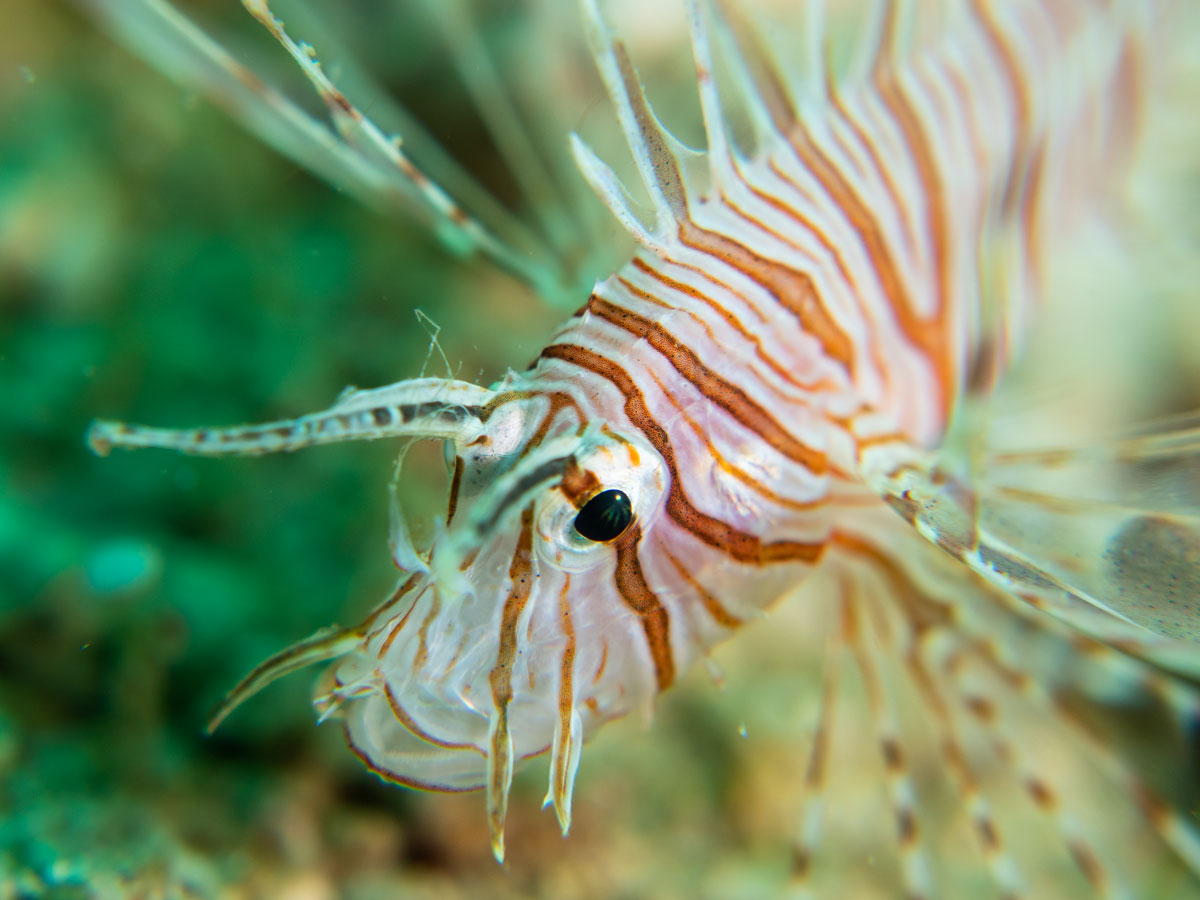Have you ever seen a scorpionfish? Perhaps you have, but you did not know it! Scorpionfish are very good at hiding in the places where they live due to their amazing camouflage abilities. If there is a scorpionfish near you while diving, you might need to look very carefully to see the fish. In addition to the name scorpionfish, informal names for other family members include the lionfish, stonefish, firefish, turkey fish, dragonfish, and stingfish.
Stone or Fish?
There are 172 different species of scorpionfish and vary greatly in size. The smallest ones are about the size of your smallest finger. Some family members, such as the lionfish, are attractive as well as dangerous.
General characteristics of family members include a compressed body, ridges and/or spines on the head, one or two spines on the operculum and three to five spines on the preopercle. The dorsal fin has 11 to 17 spines, often long and separated from each other, and the pectoral fins are well-developed, with 11 to 25 rays. The spines of the dorsal, anal, and pelvic fins all have venom glands at their bases. These bumps, folds, and frills make them look like rocks or seaweed. Scorpionfish also have coloring and markings that help them blend in with their surroundings.
Scorpion fish habitat
Most scorpionfish live in the ocean, but a few species live in freshwater. They are widespread in tropical and temperate seas but mostly found in the Indo-Pacific.
Scorpionfish typically live alone and only come together during the mating season. During the day, scorpionfish hide in caves, holes, or coral reefs; some can cover themselves in the sand or mud. They usually come out to hunt at night.
Most species are bottom-dwellers that feed on crustaceans and smaller fish. The majority inhabit shallow waters, but a few live as deep as 2,200 m. Most scorpionfish, such as the stonefish, wait in disguise for prey to pass them by before attacking, while lionfish often ambush their prey. Like many perciform fishes, scorpionfish are suction feeders that capture prey by rapidly projecting a suction field generated by the expansion of the fish’s buccal (mouth) cavity.

The lionfish and scorpion fish actually have a lot in common!
Amazing Camouflage
Many scorpaeniform fishes, such as scorpionfishes, rockfishes, and sculpins, which live on coral or rocky bottoms, possess a remarkable degree of cryptic (concealing) coloration and shape. Numerous fleshy lappets adorn the head, fin membranes, and body scales, rendering the fish virtually invisible against a background of rocks covered with marine organisms. The effectiveness of this camouflage can be appreciated best when the fish is viewed in its natural habitat.
Some members of the order, such as the sea robins, are notable for brilliant colours, especially reds. The large pectoral fins are often strikingly coloured; in the European tub gurnard (Trigla lucerna) they have spots of bright green and peacock blue. The spots on the pectorals of the flying gurnards resemble eyes and function to startle and frighten potential predators when the fins are suddenly spread. The brightly coloured fins of some sea robins may function similarly.
Scorpion fish venom
Scorpionfish are some of the most poisonous fish in the world! For example, a kind of scorpionfish called the stonefish is thought to be the deadliest fish in the world. The spines of the stonefish, like other scorpionfish, have dents in them. The poison runs through the dents and into the wound made by the spine. People have been hurt or even killed by stepping on scorpionfish that are resting on the ocean floor.
Scorpionfish do not use their spines to catch prey. They use their spines only to keep themselves safe from predators.
Scorpion fish fun facts
- If you step on a scorpionfish, the best way to treat the wound made by its spines is to run it under hot water as soon as possible. The hot water breaks down the poison.
- A scorpionfish can swallow prey that is up to half the size of its own body
- Algae grow on some kinds of scorpionfish. This makes them look even more like rocks!
- Most scorpionfish can shed their skin.
- The stonefish sometimes hunts by trapping its prey near rocks or coral reefs.
- Unlike other kinds of scorpionfish, the stonefish will sometimes jab its spines at enemies.
- The pygmy scorpionfish is only about 4 cm long.
- The leaf scorpionfish fools its prey by looking almost exactly like a leaf. It even drifts in the water like a leaf.
Komodo has many species of scorpionfish to discover so start planning your trip to the Komodo National Park soon!
Sergio Palazuelos Leon
PADI MSDT #345513
Azul Unlimited
We teach responsible scuba divers and ocean protectors. The brand is run by PADI IDC Staff Instructor Sarah Valdez who teaches scuba diving in person and on YouTube. Now she travels around the states and Mexico in her van scuba diving in new and different places. Follow her adventures on YouTube, Instagram, Facebook, and TikTok or join the Azul scuba community on Patreon.
Azul Unlimited is partnered with Azul Komodo, a top PADI IDC Center in Labuan Bajo, Indonesia offering daily dive trips to the Komodo National Park. Contact their team directly for an unforgettable experience diving in one of the top dive destinations in the world!
Scuba adventures on YouTube!
Subscribe for silly, educational scuba diving videos–totally free and designed to help all of our students wherever they are in the world. Ask your questions in the comments below each video to get direct answers from the Azul team.









